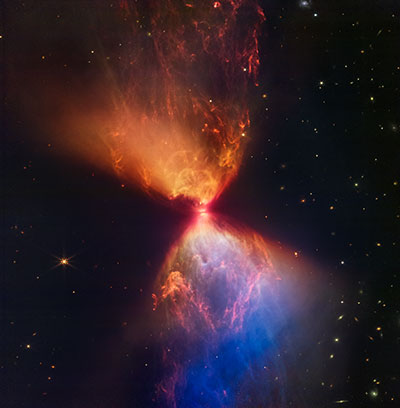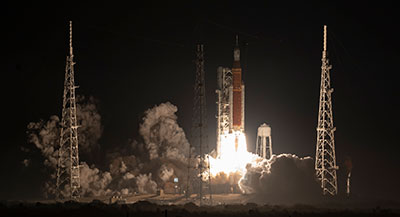June 21st, 2023
Between mountains in Hawai‘i, innovative scientists show precision timing at the quantum limit.
Last year, scientists drove up Mauna Loa volcano on Hawai‘i, aimed a laser at a reflector positioned on Haleakala peak on Maui, and beamed rapid pulses of laser light through 150 kilometers of turbulent air. While the pulses were exceedingly faint, they demonstrated a capability long sought by physicists: transmitting extremely precise time signals through the air between far-flung locations at powers that are compatible with future space-based missions.
more...
Last year, scientists drove up Mauna Loa volcano on Hawai‘i, aimed a laser at a reflector positioned on Haleakala peak on Maui, and beamed rapid pulses of laser light through 150 kilometers of turbulent air. While the pulses were exceedingly faint, they demonstrated a capability long sought by physicists: transmitting extremely precise time signals through the air between far-flung locations at powers that are compatible with future space-based missions.
more...
April 05th, 2023
By: Megan King
It’s National Bake Week here in the U.S. If you’re celebrating in your own kitchen, you may find yourself needing some aluminum foil. Whether you need a sheet of foil to keep that apple pie warm or you’re making something in an aluminum foil baking pan, foil has lots of uses in a baker’s kitchen.
Here at NIST, we do a different kind of baking, but we often use the same foil you use in your own kitchen. You won’t see our creations on The Great British Baking Show, and you definitely don’t want to eat them.
We often use foil in vacuum systems. Vacuums are spaces devoid of matter, in which air and other gases are almost completely removed. (Think about the phrase “done in a vacuum,” or to do something without any outside influences.) Vacuum chambers create pristine and highly controlled environments, so you can do things such as operating a world-class clock or studying the properties of a computer chip, without outside particles interfering.
more...
It’s National Bake Week here in the U.S. If you’re celebrating in your own kitchen, you may find yourself needing some aluminum foil. Whether you need a sheet of foil to keep that apple pie warm or you’re making something in an aluminum foil baking pan, foil has lots of uses in a baker’s kitchen.
Here at NIST, we do a different kind of baking, but we often use the same foil you use in your own kitchen. You won’t see our creations on The Great British Baking Show, and you definitely don’t want to eat them.
We often use foil in vacuum systems. Vacuums are spaces devoid of matter, in which air and other gases are almost completely removed. (Think about the phrase “done in a vacuum,” or to do something without any outside influences.) Vacuum chambers create pristine and highly controlled environments, so you can do things such as operating a world-class clock or studying the properties of a computer chip, without outside particles interfering.
more...
November 17th, 2022
Researchers at the National Institute of Standards and Technology (NIST) have created grids of tiny clumps of atoms known as quantum dots and studied what happens when electrons dive into these archipelagos of atomic islands. Measuring the behavior of electrons in these relatively simple setups promises deep insights into how electrons behave in complex real-world materials and could help researchers engineer devices that make possible powerful quantum computers and other innovative technologies.
more...
more...
November 16th, 2022
 The protostar within the dark cloud L1527, shown in this image from NASA’s James Webb Space Telescope Near-Infrared Camera (NIRCam), is embedded within a cloud of material feeding its growth. Ejections from the star have cleared out cavities above and below it, whose boundaries glow orange and blue in this infrared view. The upper central region displays bubble-like shapes due to stellar “burps,†or sporadic ejections.
The protostar within the dark cloud L1527, shown in this image from NASA’s James Webb Space Telescope Near-Infrared Camera (NIRCam), is embedded within a cloud of material feeding its growth. Ejections from the star have cleared out cavities above and below it, whose boundaries glow orange and blue in this infrared view. The upper central region displays bubble-like shapes due to stellar “burps,†or sporadic ejections.Credits: NASA, ESA, CSA, and STScI. Image processing: J. DePasquale, A. Pagan, and A. Koekemoer (STScI)
NASA’s James Webb Space Telescope has revealed the once-hidden features of the protostar within the dark cloud L1527, providing insight into the beginnings of a new star. These blazing clouds within the Taurus star-forming region are only visible in infrared light, making it an ideal target for Webb’s Near-Infrared Camera (NIRCam).
The protostar itself is hidden from view within the “neck†of this hourglass shape. An edge-on protoplanetary disk is seen as a dark line across the middle of the neck. Light from the protostar leaks above and below this disk, illuminating cavities within the surrounding gas and dust.
more...
November 15th, 2022
 NASA’s Space Launch System rocket carrying the Orion spacecraft launches on the Artemis I flight test, Wednesday, Nov. 16, 2022, from Launch Complex 39B at NASA’s Kennedy Space Center in Florida. NASA’s Artemis I mission is the first integrated flight test of the agency’s deep space exploration systems: the Orion spacecraft, Space Launch System (SLS) rocket, and ground systems. SLS and Orion launched at 1:47am ET from Launch Pad 39B at the Kennedy Space Center.
NASA’s Space Launch System rocket carrying the Orion spacecraft launches on the Artemis I flight test, Wednesday, Nov. 16, 2022, from Launch Complex 39B at NASA’s Kennedy Space Center in Florida. NASA’s Artemis I mission is the first integrated flight test of the agency’s deep space exploration systems: the Orion spacecraft, Space Launch System (SLS) rocket, and ground systems. SLS and Orion launched at 1:47am ET from Launch Pad 39B at the Kennedy Space Center.Credits: NASA/Bill Ingalls
Following a successful launch of NASA’s Space Launch System (SLS), the most powerful rocket in the world, the agency’s Orion spacecraft is on its way to the Moon as part of the Artemis program. Carrying an uncrewed Orion, SLS lifted off for its flight test debut at 1:47 a.m. EST Wednesday from Launch Pad 39B at NASA’s Kennedy Space Center in Florida.
  The launch is the first leg of a mission in which Orion is planned to travel approximately 40,000 miles beyond the Moon and return to Earth over the course of 25.5 days. Known as Artemis I, the mission is a critical part of NASA’s Moon to Mars exploration approach, in which the agency explores for the benefit of humanity. It’s an important test for the agency before flying astronauts on the Artemis II mission.
more...
November 10th, 2022
RESTON, Va.— A team of state and federal scientists have discovered an area in northern Maine that is high in critical mineral resources, highlighting for the first time the importance of this region to the U.S. mineral resource economy.
The elements were found in rocks in the vicinity of Pennington Mountain, a remote peak in central Aroostook County, about 40 miles northwest of Presque Isle, Maine. The discovery included rare earth elements, niobium, and zirconium, which are important for electronics, defense, and manufacturing applications.
more...
The elements were found in rocks in the vicinity of Pennington Mountain, a remote peak in central Aroostook County, about 40 miles northwest of Presque Isle, Maine. The discovery included rare earth elements, niobium, and zirconium, which are important for electronics, defense, and manufacturing applications.
more...


